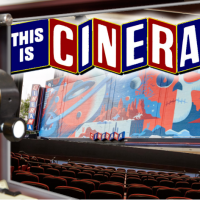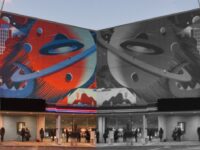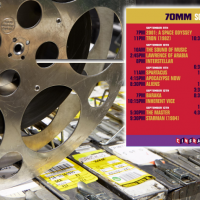Philanthropist Paul Allen passed away at age 65 on Oct. 15, 2018 from complications of non-Hodgkin’s lymphoma. The accomplishments Allen achieved in his lifetime are staggering.
These include co-founding Microsoft with Bill Gates; taking ownership of the Seattle Seahawks, who won their first Super Bowl in 2014 (Allen also owned the Portland Trailblazers); and driving numerous charitable foundations to benefit science, climate, energy, biodiversity, humanity, and arts and culture. That last item included the Museum of Pop Culture in Seattle, Wash., with another planned to open in New York City. To top it off, Allen was also a big music fan and talented guitar player.
In memory of and in tribute to Paul Allen, we’re returning to Mike Tiano’s 2016 examination of Allen’s efforts to save the Seattle Cinerama Theater.
The advent of the ground-breaking Cinerama process led to the venue’s construction at the corner of Lenora and Fourth in the Belltown neighborhood of Seattle during the closing months of the Century 21 Exposition, which is better known as the Seattle World’s Fair. In time, however, it fell into disrepair. Instead of demolishing the venue, Allen remade it into one of the finest movie palaces in the country …
The Cinerama’s new three-projector paradigm actually made its Seattle debut at the Paramount Theatre, where This is Cinerama – the first Cinerama feature – debuted at the venerable playhouse on August 22, 1956. It ran for 33 weeks, according to incinema.com. (For the sake of clarity, when used standalone “Cinerama” refers to the projection process.)
While the Seattle Paramount is known today for showcasing plays and concerts, it was originally a movie theater that was part of a chain owned by Paramount Pictures to showcase its films. Since its projection booth couldn’t accommodate the three-projector process, the machinery sat on the floor in the aisles at the back of the theater.
Using the hyperbolic tagline “It puts YOU in the picture!,” the sweeping travelogue gave the viewer vicarious thrills, with the immersive screen a major component in the process. This was an attempt to create jaw-dropping movie events at a time where an endless string of television sets popped up in American homes, and the new-but-primitive 3D process used for films was gaining a reputation of causing more headaches than pleasures.
As revealed in the archival documentation online, Cinerama wasn’t just a process, it was the star of the show, and any theaters showing films in Cinerama were warned — er, make that instructed — to ensure that it always got top billing. Some existing theaters were converted to accommodate the process, while others were built as Cinerama theaters from the ground up. This was the case of the Seattle theatre in 1963, in an effort to be in step with the World’s Fair, and constructed by the Martin Theatre chain. (The theater is located a block west of the Monorail, one of the beacons of the fair. While the fair closed in October 1962, the Monorail still operates today.)
According to the FriendsofHercules.org web site created by one of the Martin Theatre’s staff, chain owner Roy Martin’s sister, upon visiting the Atlanta Cinerama, commented that she “wished Seattle had such a venue.” Due to the makeup of the neighborhood chosen (not far from the Space Needle), the Seattle theater lacked the sprawling opulence of many of its sister Cinerama palaces: The exterior was a big, drab box and the lobby was comparatively miniscule, initially lacking a concessions stand. (The latter remains an astonishing fact, considering movie theaters depend on the sales of concessions to be profitable; one was later added.) Only the theater itself transported the attendee to a stellar movie-going experience, with its red interior design for the curtains and seating, the gigantic curved screen, and the hidden surround speakers that allowed the sounds to match the action on the screen (e.g. a subject moving from left to right, and/or back to front—graphical representations included speeding boats and buffalo herds).
The theater opened on Jan. 23, 1963 with The Wonderful World of the Brothers Grimm, featuring an all-star cast, which ran for 11 weeks. It was one of only two Cinerama features that were story driven, and not travelogues. The other was How the West Was Won, which followed at the Seattle venue on April 22, 1963, and ran a full year. These were event films: How the West Was Won also featured a huge roster of major movie stars and contained segments directed by a handful of high-caliber directors who took advantage of Cinerama’s outsized screen to depict sweeping panoramas of the American west – though reportedly John Ford had issues with the process, sometimes leaning into the frame. Cinerama was effective when each of the three panel prints melded into one seamless image; otherwise the division between each section would be obvious, and ultimately distracting, as seen in the trailer below. The result was even worse should there be a break in one of the three films.
This all came at a price that ultimately was not sustainable. Due to the exorbitant costs of creating new features, along with limited interest in the travelogues, Cinerama as a “spectacle” proved to be a passing fad and its corporation eventually began to operate at a huge loss. In order to survive, the Cinerama theaters were converted to project films in conventional formats to fill the void, including 70mm variants as well as 35mm.
The Seattle Martin Cinerama changed hands over the years and like most of its sister venues fell victim to lack of upkeep as competing mutliplexes became prevalent in the 1970s. (Early in its history, the actual Cinerama projectors were no longer used at the Seattle venue, and were removed.)
The Seattle Cinerama in Belltown seemed doomed in 1997. (It was to become a rock-climbing club, according to Wikipedia.) But in the preceding decade, the Puget Sound was booming with mega-profitable technology companies — the biggest being Microsoft, which was founded by Bill Gates and Paul Allen. Upon learning of efforts to save the Seattle Cinerama, Allen stepped in and bought the building.
Paul Allen’s devotion to Seattle cannot be overly stated. (Note the ascent of the Super Bowl-winning Seattle Seahawks since he acquired that football team.) Allen could have chosen to raze the Seattle Cinerama and build a high rise to house offices or condominiums; he would have made a handsome profit, leaving the demolished theater a hazy memory of the home for a once-innovative process. Instead, Allen’s love of the city’s culture and history — and possible nostalgia for the theater he attended while growing up — took priority over an easy profit.
It might be a coincidence that the tide seemed to be turning as audiences were eager to view event films on a large screen with surround sound in an equally enormous venue. While this might have been a factor in Paul Allen’s decision to save the theater, the Seattle Cinerama was a part of the city’s history that he could not only save but immeasurably improve by upgrading the experience and technology.
Thanks to Allen’s efforts, the Seattle Cinerama is without doubt the Northwest’s preeminent movie palace — and possibly one of the best in the country. The theater is one of the few nationwide that is equipped to project films in a wide number of formats. All new releases at the Seattle Cinerama are projected in digital, using the Christie 6P Laser technology, and can accommodate both 2D and 3D presentations. The 3D projected by the Christie system can only be viewed with Christie’s accompanying 3D glasses which are not disposable, and need to be washed after being used.
Apparently, the 3D digital projector outperforms the films being shown, particularly for the live action features: According to Cinerama Theatre Manager Phillip Finger, those are almost all filmed in 2D and are later converted to 3D, resulting in issues that include jittering. Those problems don’t occur if the feature is actually filmed with 3D cameras. This includes most animated features, and the rare live action films. This is one reason why recent 3D live action event films are screened only in 2D at this venue, as was the case for recent Star Wars and Star Trek installments.
In addition, this theater can project in both 35mm and 70mm, as well as being one of the only three theaters in the world that can show films in the original three-panel Cinerama process. In the main projection booth, all projectors are on tracks which allow the staff to move the desired projector into position with the others easily moved out of the way.
There have been several major renovations since Paul Allen acquired the building in 1998. The first overhaul was comparatively modest compared to the 21st century modifications that were to come later; nevertheless, the theater was transformed from the dingy eyesore it had become. The Cinerama projectors that were previously removed were restored, allowing the three-panel films to be exhibited in festivals where one could either relive the glory of the process, or see what the hubbub was all about.
Another renovation occurred in 2014, with substantial changes that took the venue from pretty good to mind-blowing. One did not even need to step into the theater for an indication that this was going to be the biggest round of improvements yet: the drab boxy exterior was adorned with a modern-art mural that captured the scope and awe of movies through various genres. That motif is carried over inside the theater lobby for the two display cases that flank the concession stand, where original costumes from classic movies and TV shows are on display, and are regularly rotated with others from Paul Allen’s collection. (The theater displays only a fraction of Allen’s extensive collection, where a large array of pieces can be viewed at EMP — which houses the Experience Music Project and Sci-Fi Museum — at Seattle Center, not far from the theater.)
Every effort was made to accommodate any legacy equipment and retain key design elements. In the theater itself, a new flat screen was installed for the first-run films and the festivals, which resides in front of the wider, curved Cinerama screen. It takes a full day to swap between the two, and the process can be viewed in the time lapse video below.
Other changes stressed quality over quantity throughout. All seats were replaced with high-tech designs that enhanced the aural experience for the moviegoer and to the theater acoustics overall. These seats were wider, with recessed cup holders in the arm rests — bottled drinks no longer had to be guarded from falling out and rolling down many rows, as is the case for the shallow holders found in multiplexes today. The number of rows were reduced to allow additional leg space. Seated patrons could actually stretch their legs, and no longer had to stand up or scrunch their legs to one side to allow others to pass by.
To accommodate these enhancements, the number of seats were reduced from ~800 to 570. Surprisingly, this was achieved without the huge increase in ticket prices predicted by many. What the venue lost in sheer volume was offset in increased interest (and attendance) by immeasurably enriching the movie-going experience. That included addressing accessibility for those with sight or hearing impairments. Those patrons can obtain a unit where the volume can be increased through a headset, or be used as a captioning device.
Beyond the improved seating, the theater offers high-end concessions including beer, wine, and featured food items from local establishments. One can even choose popcorn with or without a chocolate coating, or a combination of both.
There was one proposed change hotly debated by the renovation management team. When the Martin Cinerama opened in 1963, its seating was reserved, though that policy was later abandoned. For the 2014 renovation, there was discussion by management as to whether that policy should be reinstated. The argument against it was that reserved seating would result in the loss of excitement for the attendees lining up around the block, chatting about the movie while waiting for the doors to open. But considering the added tasks of scouring the dense downtown neighborhood for parking, lining up for concessions, queuing for the restroom, and scrambling to save seats for their party, having a reserved seat that waits for no one else makes all those tasks a lot less stressful.
Ultimately, these changes and modernizations providing attendees with a quality experience proved more successful than squeezing every penny from an overcrowded venue. After this recent transformation, the Seattle Cinerama has become an event theater with much to offer to residents and visitors throughout the Puget Sound who seek a top-notch movie going experience.
As technology continues to evolve at an accelerated rate, the Seattle Cinerama’s next renovation should be pretty spectacular. Until then, pass the chocolate popcorn.
©2016 Mike Tiano. All Right Reserved.
There is an enormous amount of information about the Cinerama process on the Internet, along with data on the Seattle Cinerama. While a couple of the sites below have designs that are glaringly dated, their flaws can be excused for the historical text and photographs included. For the truly inquisitive, there are more links to other sources on these pages.
• The Official Seattle Cinerama Site
• Seattle Cinerama on Instagram
• Peerless in Seattle: Enhanced Cinerama selects cream of the technology crop – Article in Film Journal International with detailed information on the 2014 renovation.
• Martin Cinerama site – Notable for the archival pictures there; check out the other links at the bottom of that page, including info and images for the original Cinerama showings at the Paramount (the first showing was 8/22/56).
• Cinema Treasures – This is a comprehensive site where you can find — and contribute — info on practically any movie theater that is currently open or is long gone.
• In Cinerama – A treasure trove of info about the Cinerama process and theaters, including instruction manual, competing processes, ticket stubs, advertising, 70mm films in the “single-lens Cinerama process” and much, much more.
• Seattle PI’s Cinerama Through the Years – A photo retrospective of the theater including the concept art for the theater and the theater interior before the renovations.
- Jon Anderson & the Band Geeks, April 14, 2025: Shows I’ll Never Forget - June 13, 2025
- Remembering Billy James: ‘He Was One of the Good Ones’ - May 15, 2025
- ‘Becoming Led Zeppelin’ (2025): Movie Review - March 11, 2025




